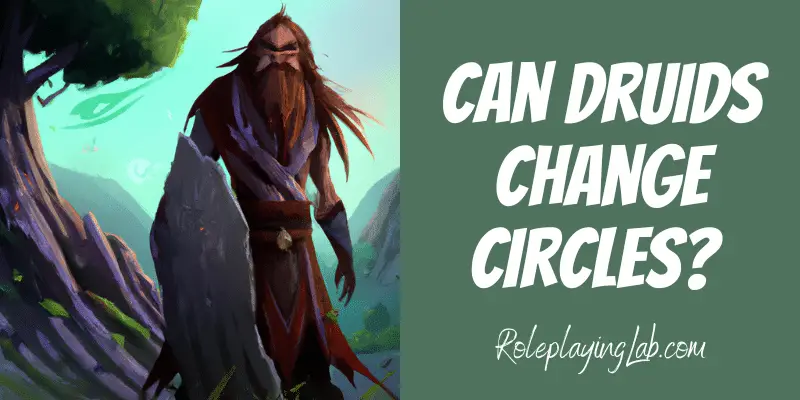One of the most unique features of druids is their ability to choose a Druid Circle, which helps define their abilities and the way they interact with the world.
Can a druid change circles?
Druids in Dungeons & Dragons cannot officially change their chosen Circle per the Player’s Handbook. Once selected, the Circle determines unique abilities and spells. However, with DM discretion or homebrew rules, options like the Wish spell or Divine Intervention might allow a change.
In this guide, you’ll learn everything you need to know about druids changing circles.
Can a Druid Change Circles? (Official Answer)

According to the official rules laid out in the Player’s Handbook, once a druid chooses a Circle at 2nd level, they are committed to it.
There is no provision in the official rules for a druid to change their Circle after this initial choice.
This reflects the idea that a druid’s Circle is not merely an occupation.
But, instead, a spiritual path and a lifestyle choice that deeply influences their abilities and outlook.
However, DND is a game that encourages creativity and flexibility.
The Dungeon Master (DM) has the final say on what is and isn’t possible in their game world.
This means that while the official rules don’t allow for Circle changes, individual DMs might have house rules that allow for such changes.
Why Would a Druid Change Circles?
A druid might desire to change Circles for various reasons.
The character could undergo significant personal growth or a change in philosophy.
Such core identity changes might prompt them to seek abilities from a different Circle.
For instance, a Druid of the Moon might feel a deeper connection to the earth’s plants over time and wish to switch to the Circle of the Land.
Another reason could be more pragmatic.
The abilities and spells offered by the original Circle might not be as useful in the current campaign as those of another Circle.
Game mechanics don’t readily allow for this switch.
Yet, the narrative richness such a change could bring to a campaign should not be discounted.
How Many Circles Can a Druid Have?
According to official D&D rules, a druid can belong to only one Circle at a time.
This limitation is part of the game’s balance, ensuring that each character has a unique set of abilities and specializations.
Mixing abilities from multiple Circles would create an unbalanced character.
That said, a creative DM might invent a quest or storyline that allows a druid to temporarily gain abilities from a different Circle, thereby bending the rule without breaking the game’s balance.
However, these would be exceptions rather than the norm and would require careful consideration.
5 Ways Druids Can Change Circles
There are at least 5 ways druids can change circles:
- Homebrew rules
- Wish spell
- Divine intervention
- Reincarnation
- Special quest or artifact
Homebrew Rules
The most straightforward way to change Circles is by using homebrew rules agreed upon by the DM and the players.
The rules could involve completing a challenging quest or undergoing a ritual to switch Circles.
Wish Spell
A druid could potentially use a Wish spell to change Circles.
However, Wish is a 9th-level spell, and using it this way might be considered a waste of such a powerful resource by some players.
Divine Intervention
A Cleric in the party could try invoking Divine Intervention to assist the druid in changing Circles.
Again, this would be subject to the DM’s discretion and could involve a quest or other conditions.
Reincarnation
In some campaign settings, a druid who dies and is reincarnated might be allowed to choose a new Circle upon their return.
However, this would be a one-time opportunity and could come with other drawbacks.
Special Quest or Artifact
The DM might create a specific quest or introduce an artifact that allows for the change.
Such a quest would likely be dangerous and high-stakes, offering a balance to the significant benefit the druid receives.
How Would Changing Circles Affect a Druid’s Abilities and Spells?
Changing Circles would dramatically affect a druid’s abilities and spells.
Druid Circles provide unique features, spells, and bonuses that differentiate one druid from another.
Upon switching Circles, a druid would lose all abilities, spells, and features associated with their previous Circle and gain those of the new Circle.
This could result in significant changes in gameplay, as the druid’s role within the party may also shift.
For example, switching from Circle of the Moon to Circle of the Land would shift a character from a combat-focused role to a more spellcasting-oriented one.
Homebrew Rules for Changing Druid Circles
If your group is open to bending the official rules, implementing a homebrew rule for changing Druid Circles can add depth to your campaign.
One option could be to design a ritual requiring the collection of rare materials related to the new Circle.
Then follow that up with a period of meditation and training.
This process could also come with in-game challenges.
Challenges like having to protect the ritual site from hostile creatures or completing it within a time limit.
Another homebrew rule could be that the druid needs to seek the blessing of a higher-level druid from the Circle they wish to join.
This could involve completing quests or challenges set by that druid.
It could also require the character to renounce their former Circle officially.
Of course, this means losing all abilities from it as they gain the new Circle’s abilities.
Allowing druids the option to change Circles introduces new role-playing opportunities.
However, it’s crucial to maintain balance and ensure that the process is neither too easy nor excessively difficult.
What Are the Narrative Implications of a Druid Changing Circles?
From a storytelling perspective, changing Circles can offer a rich vein of narrative opportunities.
The character could go through a spiritual or philosophical transformation, reflecting their new Circle’s principles.
The change might require a quest for a sacred place or artifact, offering an adventure hook.
The character’s relationships with NPCs and other party members might also change, depending on how they view the druid’s new path.
It can also add complexity to a character’s backstory, perhaps forcing them to reconcile with or break away from past mentors or traditions.
Changing Circles (My Personal Stories)
As a player, I’ve faced several instances where changing Circles felt like a natural progression for my character.
I once played a Druid of the Moon deeply connected to animals and shape-shifting.
However, as our campaign moved to a bustling city setting, my character felt increasingly out of place, leading me to wish for a switch to the Circle of Dreams.
In another campaign, our DM crafted a unique quest allowing my Druid of the Land to switch to the Circle of the Shepherd.
The experience was memorable and enriched both my character’s journey and the overall story.
On a different occasion, a Cleric in our group invoked Divine Intervention to assist my druid in changing Circles, which came with a fascinating twist—losing all memories of the former Circle’s teachings.
I’ve also been tempted to use a Wish spell to facilitate this change.
But wisely chose to save it for more critical moments.
Lastly, one of my most memorable experiences involved finding my character’s old mentor to train under him, thus allowing a Circle change while also evolving my character’s personal story.
Druid Circle FAQ
Before we end this article, I want to answer a few common questions about Druid Circles.
How Many Druid Circles Are There?
There are several Druid Circles that players can choose.
At the moment, here are seven primary Druid Circles introduced in various official publications:
- Circle of the Land
- Circle of the Moon
- Circle of Dreams
- Circle of the Shepherd
- Circle of Spores
- Circle of Stars
- Circle of Wildfire
It’s essential to note that with new publications, additional Druid Circles may be introduced.
Players should consult the most recent official sources or their Dungeon Master to determine all available options in their specific game setting.
Which Druid Circle Is Best?
My personal preference is the Circle of the Moon.
However, the optimal Druid Circle depends on a player’s preferred playstyle and the campaign’s context.
Each Circle offers distinct abilities tailored to different roles:
- Circle of the Land: Best for druids focusing on spellcasting, with spells related to specific terrains.
- Circle of the Moon: Ideal for those keen on combat and frequently using their Wild Shape to become powerful creatures.
- Circle of Dreams: Suited for supportive roles, drawing from the Feywild to aid and heal allies.
- Circle of the Shepherd: Perfect for those enjoying summoning and strengthening creatures in combat.
- Circle of Spores: Merges the themes of decay and growth, with unique fungal abilities and damage potential.
- Circle of Stars: Revolves around cosmic magic, providing astral-themed abilities and insights.
- Circle of Wildfire: Harnesses the energies of fire and rebirth, aiding in flame control and summoning wildfire spirits.
Here is a good video about the Circle of Moon Druid (and why it might be best):
Final Thoughts: Can a Druid Change Circles?
As the leaves of the ancient trees turn and seasons change, so too might a druid’s calling.
Whatever Circle one might choose or contemplate, the heart of a druid remains evergreen, forever in tune with the world’s rhythm and whispering secrets of the wilds.
Related Posts:
- DND: What Can Druids Turn Into? (Best 21+ Wild Shapes)
- DND: Can Druids Wear Metal? (Official Rules Explained)
- Warlock Subclasses in DND: Ultimate Guide & Rankings
- Can You Wear Animated Armor in DND? (Solved)

